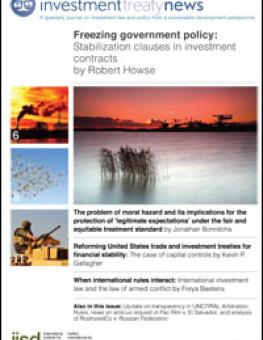
Investment Treaty News Quarterly, Volume 1, Issue 3, April 2011
In this issue:
Freezing government policy: Stabilization clauses in investment contracts; The problem of moral hazard and its implications for the protection of ‘legitimate expectations' under the fair and equitable treatment standard; Reforming United States trade and investment treaties for financial stability: The case of capital controls; When international rules interact: International investment law and the law of armed conflict; RosInvestCo v.Russian Federation; Nations Energy Inc., et al. v. Republic of Panama; Cemex v. Venezuela; Mohammad Ammar Al-Bahloul v. Republic of Tajikistan; Transparency in UNCITRAL Arbitration Rules; Amicus request in Pac Rim v. El Salvador; Lead producer files notice of intent to arbitrate against Peru; Canadian organizations petition European Parliament over investment pact
Additional downloads
You might also be interested in
Why the Energy Charter Treaty Modernization Doesn't Deliver for Climate
The Energy Charter Conference adopted the "modernized" Energy Charter Treaty (ECT) on December 3, 2024. IISD's Lukas Schaugg explains what the modernization does, when it will enter into force, its tension with EU law, and why the reformed ECT can still hinder climate policies.
The Responsible Agricultural Investment Tool for Agribusiness and Case Studies
This report summarizes a collaboration to support agribusinesses in complying with principles of responsible investment in agriculture and food systems.
Stabilization Clauses: The hidden provisions that can hinder tax and investment policy reform
Stabilization clauses should no longer automatically be included in contracts between states and investors. If they are, they should, at a minimum, build on the latest international standards on stabilization to avoid being a barrier to sustainable development.
What Drives Investment Policy-makers in Developing Countries to Use Tax Incentives?
The article explores the reasons behind the use of tax incentives in developing countries to attract investment, examining the pressures, challenges, and alternative strategies that exist.